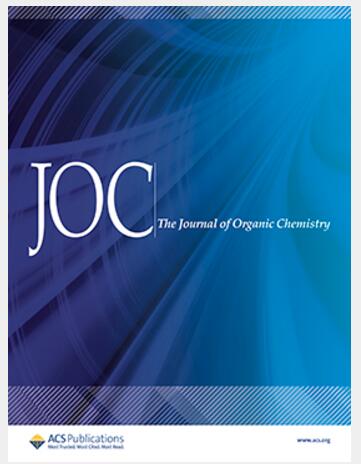卤素原子和亲核试剂的反应活性对四氢吡喃和四氢呋喃缩醛与c -亲核试剂反应的影响:超共轭和诱导效应。
IF 3.6
2区 化学
Q1 CHEMISTRY, ORGANIC
引用次数: 0
摘要
带有氟原子的四氢吡喃缩醛与缩醛碳原子相邻,可与亲核烯烃发生高度立体选择性取代反应,生成1,2-顺式产物。相反,氯和溴取代的缩醛则生成1,2-反式产物。这些结果可以通过考虑氧碳离子中间体及其构象偏好来理解,这些构象偏好是由轴向取代基的超共轭效应决定的,其中F≪H < Cl < Br。相应的五元环缩醛与氟的反应也具有1,2-顺式选择性,与氯和溴取代缩醛的反应也具有1,2-反式选择性,但选择性表现出不同的反应性和选择性趋势。由于获得取代产物所需的条件,与五元环缩醛的反应被解释为需要端粒卤化物作为反应中间体。本文章由计算机程序翻译,如有差异,请以英文原文为准。
Influence of Halogen Atoms and the Reactivity of Nucleophiles on Reactions of Tetrahydropyran and Tetrahydrofuran Acetals with C-Nucleophiles: Hyperconjugation and Inductive Effects.
Tetrahydropyran acetals bearing a fluorine atom adjacent to the acetal carbon atom can undergo highly stereoselective substitution reactions with nucleophilic alkenes to give the 1,2-cis products. By contrast, the chlorine- and bromine-substituted acetals give the 1,2-trans products. These results can be understood by considering oxocarbenium ion intermediates and their conformational preferences, which are dictated by hyperconjugative effects from axial substituents, with F ≪ H < Cl < Br. Reactions of the corresponding five-membered-ring acetals are also 1,2-cis selective in the case of fluorine and 1,2-trans selective with chlorine- and bromine-substituted acetals, but selectivities showed different trends of reactivity vs selectivity. The reactions with the five-membered-ring acetal were interpreted as requiring anomeric halides as reactive intermediates because of the conditions required to obtain substitution products.
求助全文
通过发布文献求助,成功后即可免费获取论文全文。
去求助
来源期刊

Journal of Organic Chemistry
化学-有机化学
CiteScore
6.20
自引率
11.10%
发文量
1467
审稿时长
2 months
期刊介绍:
Journal of Organic Chemistry welcomes original contributions of fundamental research in all branches of the theory and practice of organic chemistry. In selecting manuscripts for publication, the editors place emphasis on the quality and novelty of the work, as well as the breadth of interest to the organic chemistry community.
 求助内容:
求助内容: 应助结果提醒方式:
应助结果提醒方式:


